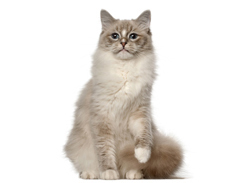Ragdolls have medium-long, soft, silky hair and point patterns. They come in seal, chocolate, blue, lilac, red, and cream colorations, and in three patterns: bi-color with white, mitted with white, and colorpoint with no white. Ragdoll points can be solid, lynx, tortie, or torbie. These are large cats, with males reaching 15 to 20 pounds and females staying smaller at 10 to 15 pounds. They have wedge-shaped heads and beautiful, innocent blue eyes.
Ragdoll cats are intrigues by water. Don't be surprised if one appears in the bath or shower. They are also known for being particularly interested in food, even by cat standards.
These cats are sweet, mellow, and people-oriented, following humans around eagerly. They love attention, but they don't resort to attention-seeking behaviors to get it. Ragdolls take their name from the way they go limp with pleasure and relaxation when they are petted. They get along famously well with children and other animals, and belong in homes where they have lots of companionship.
Ragdoll cats are intrigued by water. Don't be surprised if one appears in the bath or shower. They are also known for being particularly interested in food, even by cat standards.
Ragdolls are mild-mannered but keenly interested in their humans, following them around and taking advantage of their laps whenever possible. They have a deep-seated desire for attention and affection, but they are content to take it as it comes. However, they do become upset when left alone too often or too long.
These cats aren't hyper, but they do enjoy games and physical activity, retaining a kitten-like playfulness through life. They interact very well with children, indulging the whims of the young and playing along with their games. Ragdolls also get along well with other pets, and even enjoy their company.
Ragdolls aren't overly vocal, but they do talk in soft, musical voices from time to time. Their sweet faces, expressive eyes, and plush exteriors make it easy to provide them with the petting and attention they want.
Ragdolls mature slowly for cats, taking about 4 years to fully develop. They experience rapid growth spurts as kittens and should have free access to food while growing. However, once they reach maturity, guard against obesity in these food-loving cats by rationing and encouraging physical activity. Cats of this breed are generally healthy and can live 15 years or more.
These cats have a genetic predisposition to developing bladder stones. They are also at increased risk for developing hypertrophic cardiomyopathy (HCM). This is the leading cause of heart disease in domestic cats, but it's detectable by genetic screening and echocardiogram.
Responsible breeders remove Ragdolls from breeding lines if screenings show the gene associated with HCM. Ask for verification of screenings of kittens and their parents. While all breeders should be willing to provide a written guarantee of good health, none can guarantee a cat won't ever develop HCM or other medical problems.
Ragdolls can be easily trained to stay off counters, walk on a leash or harness, and play games like fetch. As long as they have plenty of company and receive lots of attention, they remain docile, loving, and otherwise well-adjusted.
Puzzle toys and interactive games provide much-needed stimulation for the Ragdoll, both physically and mentally, but sometimes these cats are content to just lay around in a lap. They aren't as interested in climbing as many other cat breeds, and they tend to stick close to the ground.
Ragdolls are adaptable and do well with travel. However, they are poorly suited to spending any unsupervised time outdoors. They are far too calm and trusting for the many dangers lurking outside the home. These cats are friendly enough to interact with unfamiliar guests, not displaying much of the typical feline skittishness.
Ragdolls are moderate shedders with relatively low-maintenance coats. Their hair should be combed with a stainless steel comb once or twice per week, and a few extra times per week during shedding season. This is generally adequate for preventing matting and tangles in the Ragdoll's silky fur and for limiting hairballs and hair around the home.
Other required grooming is just standard cat care. The ears should be checked for wax or debris and cleaned when necessary using a feline otic cleanser and cotton balls. Also, the ears should be checked for possible indications of an ear infection, such as redness, swelling, discharge, and foul ear odor. The nails need clipping once every 10 to 14 days with sharp scissors or a guillotine-style blade, and the teeth should be brushed as often as possible.
Ragdolls are more tolerant of grooming procedures than many other cats, primarily because they crave human touch. They can be made more accepting of these practices by beginning grooming early in life and by handling the breed's paws, toes, ears, and mouth frequently.
Development of the Ragdoll is credited to a California-based breeder named Ann Baker. In the 1960s, she was caring for a cat named Josephine. Legend has it that Josephine produced unremarkable offspring until being struck by a car and recuperating. Thereafter, her kittens were said to be sweet, docile, and prone to going limp in a human's arms or lap.
A number of stories exist about the origins of the breed, but Baker closely guarded her methods and insisted on closely controlling breeders. When some broke away from her, she formed the International Ragdoll Cat Association (IRCA) in 1971 for registration purposes and trademarked the name Ragdoll.
To avoid infringing on the trademark and to skirt around contractual obligations to Baker, some breeders coined the name RagaMuffin for their cats, which they bred in many more colors and patterns than were accepted for Ragdolls. Even with the branch off, Ragdolls continued to steadily achieve more popularity, and today they are the sixth most popular breed listed by the Cat Fanciers' Association (CFA).
The CFA began accepting Ragdolls for registration in 1993.

